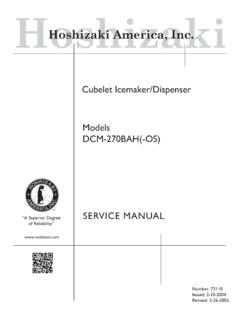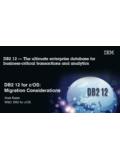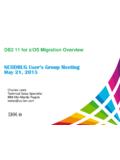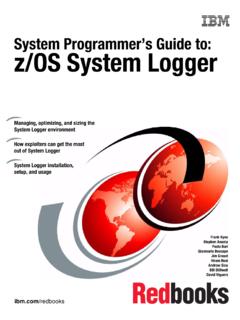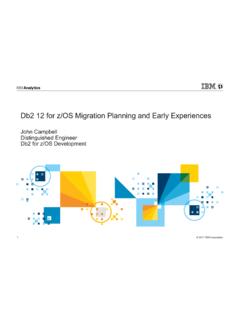Transcription of Stu Henderson’s Clear Explanation of Effective z/OS ...
1 How to Audit z/OS Security Copyright 2011, Stuart C. Henderson, All Rights Reserved Page 1 Stu Henderson s Clear Explanation of Effective z/OS Security Auditing (A Brief Description of the Steps to a Proven Practical Audit Program, Without Much Technical Detail) Stu Henderson The Henderson Group 5702 Newington Road Bethesda, MD 20816 (301) 229-7187 How to Audit z/OS Security Copyright 2011, Stuart C. Henderson, All Rights Reserved Page 2 Abstract: IS (Information System) audits are sometimes not well received or are thought to be irrelevant. In this session, Stu shows you a practical audit program for MVS (z/OS) security that produces meaningful findings and recommendations.
2 The approach described here will result in more Effective audits and can be used to good advantage by security administrators and system programmers as well. Stu shows you how to change the focus of an audit from a judgmental, checklist-based approach to one that emphasizes impartial evaluation of the tools available to systems management. I Introduction This paper shows you how to conduct z/OS mainframe audits, specifically security audits of IBM s MVS operating system software for mainframe computers. (Note that z/OS is a package of software programs which includes the MVS operating system. MVS is comparable to UNIX or Windows.)
3 It is the program that starts up when the computer is turned on. It controls all users, programs, and resources on the computer.) This paper does not address security software (such as CA ACF2 for z/OS (CA ACF2), CA Top Secret for z/OS (CA Top Secret), or IBM s RACF) except as they affect operating system security. Please note that a weakness in MVS security will undermine the reliability of the security software. In the other direction, weak security software implementation will undermine MVS security. The approach we use here avoids rote checklists and criticisms of how a given installation functions. We start instead with the hardware controls that form the basis of MVS security.
4 IBM gives us written assurance that MVS reliably uses these hardware controls to prevent users from interfering with each other and with MVS itself. IBM also gives us several standard techniques (or backdoors ) for system programmers to add programs to the system with privileges which bypass the hardware controls. (This paper will not explain the details of the hardware controls, nor the details of the techniques such as APF (Authorized Program Facility) authorization used to give programs these privileges. For more details on this, please see the Further Information resources at the end of this paper.) We will illustrate our approach with examples from two software products: CA Auditor for z/OS (CA Auditor, which many people still call by its old name: CA Examine) and CA Compliance Manager for z/OS (CA Compliance Manager), both from CA Technologies, which used to be called Computer Associates.
5 How to Audit z/OS Security Copyright 2011, Stuart C. Henderson, All Rights Reserved Page 3 Who This Is For and What You Should Expect This paper is designed for IS (Information Systems) auditors who will be conducting mainframe audits, as well as system programmers and security administrators, and those responsible for self-assessment reviews in advance of scheduled audits. It assumes some basic knowledge of mainframes and auditing. Readers will find that there is no in-depth Explanation here of how the hardware controls and backdoors work. That would require a much larger document. Instead, readers will learn the basic steps to an Effective MVS security audit, with the understanding that any needed technical knowledge can be acquired elsewhere and fit neatly into the framework presented here.
6 The Hardware Controls and the Integrity Statement IBM mainframe computers (the z series ) have three hardware controls which form the basis of all MVS security. We list them here with a brief description of what each one does: The Supervisor State Switch (restricts when a program can execute privileged hardware instructions [such as the instruction to change the date and the instruction which writes directly to a disk drive]) Protect Keys (restrict what memory a program can update or read) Address Spaces (restrict what memory a program can touch) The MVS operating system uses these three controls to build a virtual cage around each program running on the computer.
7 This virtual cage prevents each program from interfering with other programs executing at the same time, and also from interfering with MVS itself. These hardware controls and the virtual cages MVS constructs from them are the basis of MVS security. This architecture is so solid that IBM provides us with written assurance that no program can break out of its virtual cage unless you modify the system to permit this. This assurance is in the form of IBM s Integrity Statement for MVS, details of which may be found at the end of this document. IBM also provides several standard methods for you to modify the system to give a specified program privileges which permit it to break out of its virtual cage.
8 Such programs (called privileged programs or back doors ) can bypass all security on the system, including that provided by CA ACF2, CA Top Secret, and IBM s RACF. How to Audit z/OS Security Copyright 2011, Stuart C. Henderson, All Rights Reserved Page 4 Such modifications to the system are not covered by IBM s Integrity Statement for MVS. IBM rightly considers data center management responsible for ensuring that these modifications do not introduce security exposures to your system. The standard ways IBM gives us to permit a program to break out of its virtual cage are: User Supervisor Calls APF Authorization and TSO APF Authorization I/O Appendages Functional Sub-Systems Exits (assembler or REXX language programs which can modify the logic of standard software) The Program Properties Table Various methods (such as SRB scheduling) to cross address space boundaries.
9 This audit program will not center on address space backdoors, since they are effectively controlled by automatic means. A typical mainframe installation may have hundreds of such backdoors. The concept of a backdoor is not good or bad. It is practical. (You may have a backdoor on your house. Your insurance agent expects you to lock it at night.) We need to be able to know however that they don t introduce security exposures to our systems. Our audit approach assumes that IBM s Integrity Statement provides us with sufficient assurance that the MVS security architecture can be relied upon. So we start by identifying all the instances where the system programmers have added privileged programs to the system, since these are not covered by the Integrity Statement.
10 What We Are Auditing and How Our job as auditors is not to evaluate these privileged programs. Rather it is to evaluate the tools available to system programming management for them to know that the backdoors: Have All Been Approved (that is, should be there) Are Safe (which means doesn t permit unauthorized users or programs to break out of their virtual cages) Cannot Be Modified Without Authorization and Detection How to Audit z/OS Security Copyright 2011, Stuart C. Henderson, All Rights Reserved Page 5 Answers to these questions will help the financial auditors to address their own questions regarding numbers processed on the mainframe: Are the numbers reliable?



